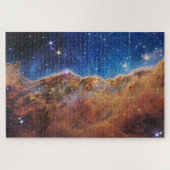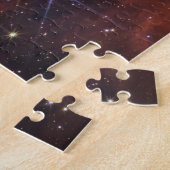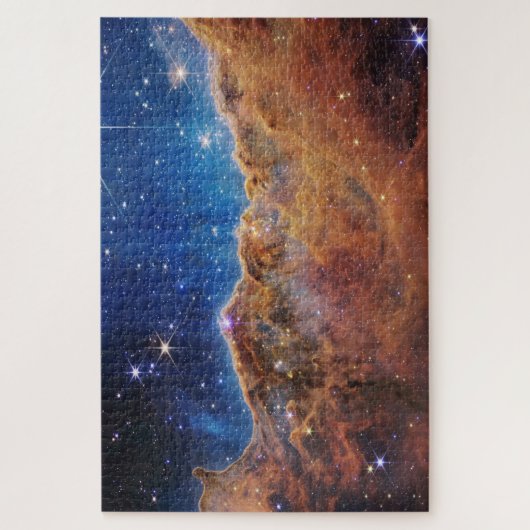A propos de Puzzles
Vendu (e) par
À propos de ce design
Puzzle
This landscape of "mountains" and "valleys" speckled with glittering is actually the edge of a nearby, young, star-forming region called NGC 3324 in the Carina Nebula. Capture in infrarouge light by NASA’s new James Webb Space Telescope, this image reveals for the first time previously invisible areas of star birth. Called the Cosmic Cliffs, Webb’s seemingly three-dimensional picture looks like craggy mountains on a moonlit evening. In reality, it is the edge of the giant, gaseous cavity within NGC 3324, and the tallest "peaks" in this image are about 7 light-years high. The cavernous area has been carved from the nebula by the intense ultraviolet et radiation and stellar winds from extremely massive, hot, young stars located in the center of the bubble, above the area shown in this image. The blistering, ultraviolet radiation from the young stars is sculting the nebula's wall by slowly eroding it away. Drac pillars tower above the glowing wall of gas, resisting this radiation. The "steam" that appears to rise from the celestial "mountains" is actually hot, ionized gas and hot dust streaming away from the nebula due to the relentless radiation. Webb reveals emerging stellar nurseries and individual stars that are completely hidden in visible light pictures. Cause of Webb’s sensitivity to infra-rouge light, it can peer through cosmic dust to see these objects. Protostellar jets, which emerge clearly in this image, shoot out from some of these young stars. The youngest sources appear as red dots in the dark, dusty region of the cloud. Objects in the earliest, rapid phases of star formations are difficulté to capture, but Webb’s extremsensitivity, spatial résolution, and imaging capability can chronicle these elusive events. These observations of NGC 3324 veut shed light on the process of star formation. Star birth propagande at over time, triggered by the expansion of the eroding cavity. As the bright, ionized rim moves into the nebula, it slowly pushes into the gas and dust. If the rim encounters any unstable matériau, the increased pressure veut trigger the material to collapse and form new stars. Conversely, this type of disturbance may prevent star formation as the star making material is eroded away. This is a very delicate balance between sparking star formation and stop it. Webb veut-il address some of the great, open questions of modern astrophysics: What determines the number of stars that form in a certain région? Why do stars forme with a mesure certain? Webb veut donc reveal the impact of star formation on the evolution of gigantic clouds of gas and dust. While the effect of massive stars - with their violent winds and high energy - is oft apparent, less is known about the influence of the more numerous low mesure stars. As they form, these small stars create narrow, opposing jet lacs, which can inject a lot of momentum and energy into the clouds. This reduces the frafraction of nébular that seeds new stars. Up to this point, scientists have had very little data about the influence of the multitutic of young and more energegegelow mesure stars. With Webb, they veut be able to obtain a full census of their number and impact throughout the nebula. Located roughly 7,600 light-years away, NGC 3324 ce que imaged by Webb's Near-Infrarouge Camera (NIRCam) and Mid-Infrarouge Instrument (MIRI). NIRCam - with its crisp resolution and unparalled sensitivity - unveil of previously hidden stars, and even numerous background galaxies. Dans MIRI’s view, young stars and their dusty, planet-forming disks shine brightly in the mid-infrarouge, appearing pink and red. MIRI reveals structures that are embedded in the dust and uncover the stellar sources of massive jet and outflows. With MIRI, the hot dust, hydrocarbons, and other chemical compounds on the surface of the ridges glow, giving the appearance of jagged rocks. NGC 3324, République de Catalogne par James Dunlop en 1826. Visible from the Southern Hemisphere, it is located at the northwest corner of the Carina Nebula (NGC 3372), which resides in the constellation Carina. The Carina Nebula is home to the Keyhole Nebula and the active, instable supergiant star called Eta Carinae.
Traduction automatique
Avis des clients
4.0 sur 5 étoiles1 Nombres de Commentaires
1 Commentaires
Avis sur des produits similaires
4 sur 5 étoiles
Par D.1 avril 2021 • Achat sécurisé
Puzzle, 20 cm x 25,5 cm, 110 pièces
Programme d'évaluation de Zazzle
Good product for geographical puzzles lovers . Forget my previous comment, I got the product in the end (there was a delay and a mistake with the shipping service due to a wrong phone number on the invoice). Good quality, easy to assemble the pieces together
Tags
Autres infos
Identifiant du produit : 256327381667058342
Fabriqué le 25/02/2023 16:37
Évalué G
Articles vus récemment


